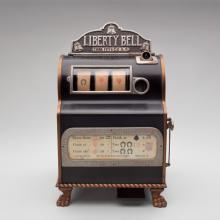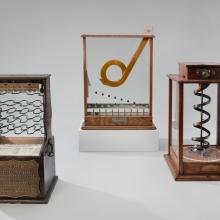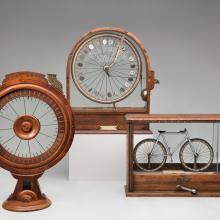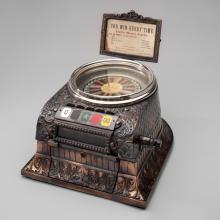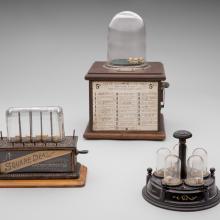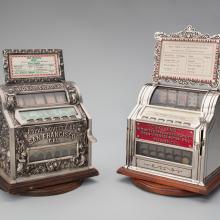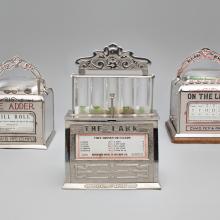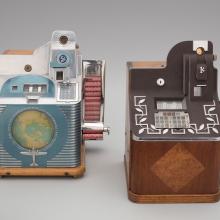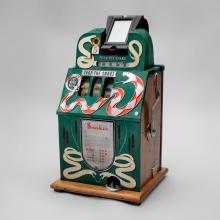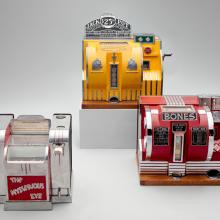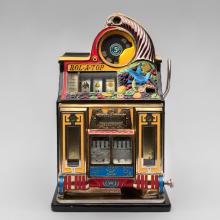Terminal 3


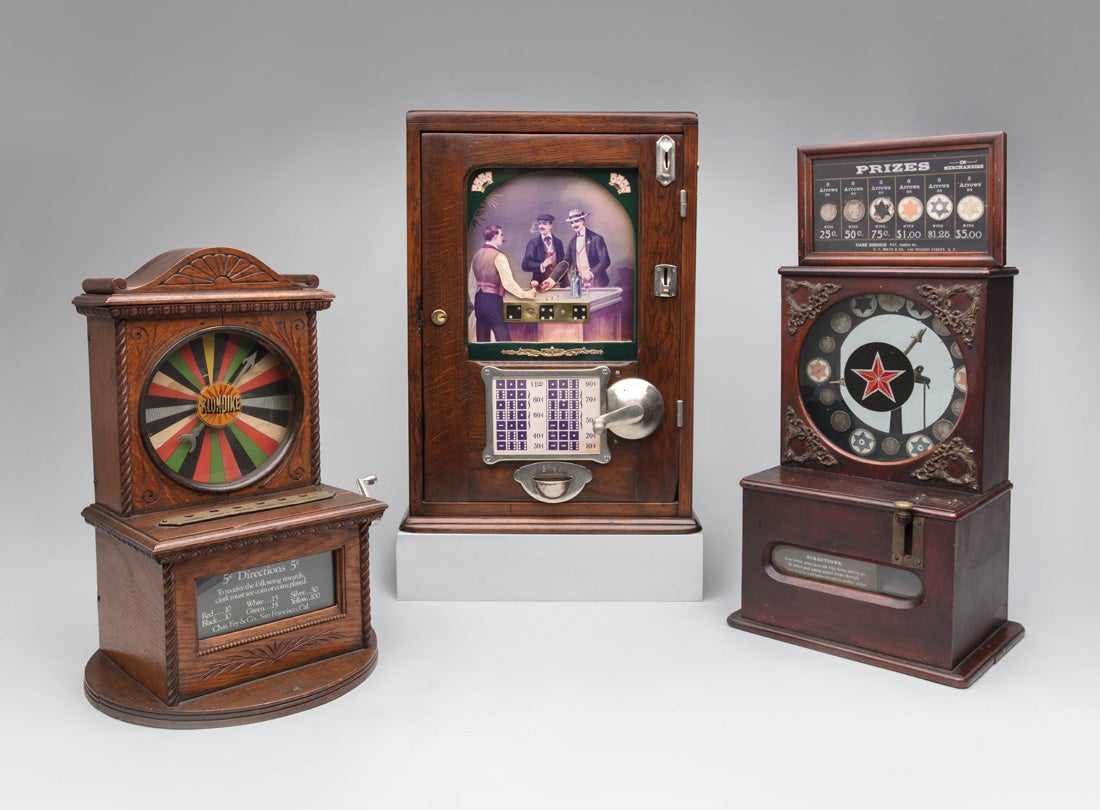




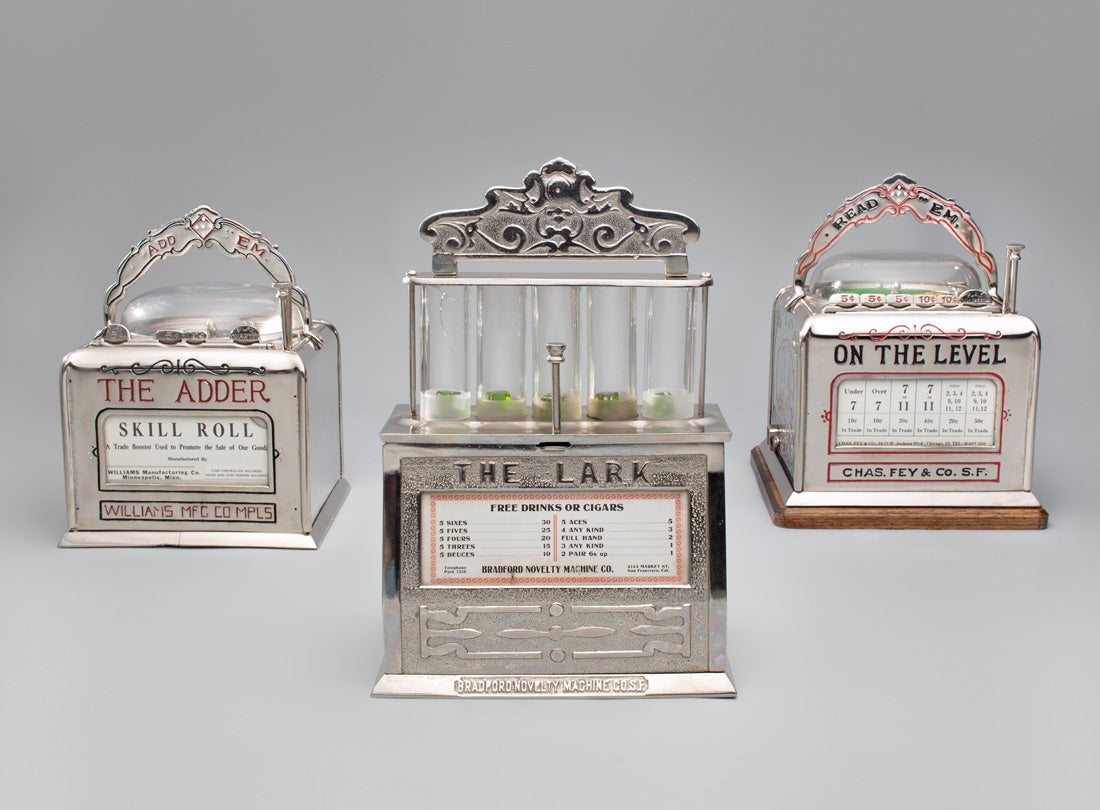




Liberty Bell 1898
Charles Fey & Co., San Francisco
metal, paint, glass, paper, ink
Courtesy of Joe Welch American Antique Museum
L2016.2501.001
The Original
Inventor Charles Fey had been making coin-operated machines in San Francisco for nearly ten years prior to creating his Liberty Bell in 1898. Although other payout machines preceded it, the Liberty Bell was the first automatic-payout, three-reel machine. It established the standard for more than a million slot machines made by other manufacturers during the twentieth century.
Because only three symbols of the thousand combinations (10 x 10 x 10) were shown with each spin, players could not calculate the payout percentage as they did on the hundred-combination color-wheel machines. In addition, three reels were far more entertaining with more suspenseful, near-miss opportunities than the single stop of an exposed color-wheel payout disc. Fey’s invention became an instant success.
By choosing an image of Philadelphia’s Liberty Bell to join the popular star, horseshoe, and card symbols, Fey made his machine instantly recognizable. He also introduced a symbol used by nearly every manufacturer thereafter, and which inspired the generic term for the devices—Bells. Fey made Liberty Bells for distribution on his own operator routes, and they were never released on the open market. Of the nearly one hundred models produced, seven are known to exist today.
The Lively Cigar Seller 1893 | Loop-The-Loop 1901 | Spiral 1906 |
Coin Drops
Prior to the predominance of the three-reel, automatic-payout slot machine, early mechanical gambling devices employed a variety of clever actions to induce patrons to drop their coins and try their luck. The Clawson Slot Machine Company in Newark, New Jersey, founded by industry pioneer Clement Clawson in 1889, was the first firm to produce a diverse line of gambling machines. Clawson’s “Latest and Best,” the Lively Cigar Seller, operated on the simple principle of heads-or-tails and presented a prominent patent warning on the face of its cabinet.
One can only imagine the techniques employed by players attempting to affect the course of their coins in Kelley’s simple coin-in-chute device, the Loop-The-Loop or E. D. Parker’s Spiral.
Klondike 1897 | Domino early 20th century | Holtz trade stimulator 1896 |
Holtz and Fey
San Francisco-based machinists and inventors Theodore Holtz and Charles Fey were important pioneers in the development of early gambling devices. The men were business partners and remained close friends after separating their professional collaboration in 1896, the year Holtz introduced this trade stimulator. The machine is similar in appearance and operation to Charles Fey’s Three-Spindle, also made in 1896. Makers often copied the designs of others’ machines, and sometimes replaced the play card of an existing device with one of their own.
Charles Fey’s Klondike was named for the Alaskan gold rush that began the year before the machine’s introduction in 1897—when the name Klondike was foremost on the minds of a population enchanted by the idea of fortune “there for the taking.” Klondike was one of the first multiple-coin machines. Each stop on the wheel paid the award indicated on the play instructions. The lever on the right side of the cabinet was pressed to spin the arrow after nickels were placed in one to six of the machine’s slots to select the color or colors. If the arrow landed on a winner, the player was awarded as many as twenty-five drinks, which were payable at the bar. The Klondike was one of the most popular machines serving San Francisco’s numerous saloons at the turn of the twentieth century.
While card games were a common subject for gambling devices, another popular barroom game inspired this attractive machine from the Domino Company of Philadelphia. If the player’s dominoes struck the proper combination, the articulated bartender and patron on the machine’s front panel raised their glasses to salute the winner.
Fairest Wheel 1895 | The Bicycle Wheel 1895 | Bicycle 1896 |
Wheels of Fortune
A form of machine called the Discount Wheel was allowed to operate in locations where games of chance were forbidden. Patrons received a “five-cent cigar” when inserting their nickel for an opportunity to win extra prizes or value in trade. An estimated 250,000 wheel devices were in use at the turn of the twentieth century.
The bicycling craze of the 1890s inspired a variety of unusual trade stimulators, including the appropriately named Bicycle, which utilized imagery of the healthful new sport to secure wide distribution. The player’s only exercise, however, was to drop a nickel in the machine and turn a lever. A bell rang, tires spun, and indicators pointed to a number on the wheel’s rims to determine the outcome.
Little Monte Carlo c. 1900
Mills Novelty Co., Chicago
metal, glass, enamel, paint
Courtesy of Joe Welch
American Antique Museum
L2016.2501.046
Countertop Roulette
During the late 1890s, as machining became prevalent and mechanical appliances were increasingly accessible, slot machine companies proliferated. Many of the color-wheel and roulette-based gambling devices, popularized as freestanding machines in carved, wooden cabinets, were also produced as ornate, cast-iron versions for the countertops of saloons and cigar stores. The Little Monte Carlo allowed five-way play with payouts determined by the color played. Mills Novelty Company produced this popular roulette machine from 1899 to 1915
Square Deal 1891 | Dice machine fortune teller c. 1900 | Dice machine with five cylinders c. 1900 |
Early Dice Machines
A wide range of gambling devices employed dice that were “tossed” under glass domes. Although later machines offered awards based on reading the dice to achieve high poker hands or to simulate craps, most of those made at the turn of the twentieth century were simple devices that paid on the dice totals, usually from five to thirty. A nickel-playing fortune teller offered predictions and advice with the cash payout, including one dollar awarded for five of a kind, and the admonition—“Thirst not after riches, they will prove destructive.”
Royal Trader 1902 | Oakland 1902 |
Two Cards Shy of a Full Deck
The poker machine was the most popular gambling device at the turn of the twentieth century. The play format was easily identifiable and understood by those familiar with the card game. A hand was dealt, desired cards were selected to hold, and a final “deal” of cards determined the outcome. These two versions made on opposite sides of San Francisco Bay were mounted on revolving platters to allow proprietors to easily examine claims made by the machines’ players. The Royal Novelty Company in San Francisco produced this ornately decorated, cast-iron, card-on-reel version, while the Oakland Novelty Company employed a card-on-spindle device decorated with two time-honored lucky symbols—stars and horseshoes. Both machines employed a total of fifty playing cards from a complete deck of fifty-two, with the two missing cards making the jackpot, achieved by a royal flush, difficult to win.
The Adder c. 1907–15 | The Lark 1907 | On the Level 1906 |
“Read Em”
Bradford Novelty’s The Lark used five dice for an opportunity to achieve winning poker hands, while Charles Fey’s On the Level operated on the principle of craps, a popular dice game. The side panels of Fey’s machine were decorated with a particularly Californian flair—oak leaves and a grizzly bear perched on dice. The Adder was one of a variety of machines that evolved from Charles Fey’s popular device. While most components were identical to On the Level, a roulette wheel replaced the dice field, changing the essence of the game. A die served as the decorative motif on top of both machines, but the phrase “Add Em” replaced “Read Em” on the roulette version.
Dial c. 1935 | Smoker 1939 |
Discrete Devices
Mills’ Dial was produced with a modern, streamlined cabinet depicting a plane flying toward the North Pole with a variety of destinations and conditions listed around the circumference of the globe. The theme capitalized on the nation’s infatuation with commercial air travel, a recently introduced luxury. Dial featured the distinctive top-view silhouette of a Boeing 247—a highly advanced passenger airliner that incorporated retractable landing gear and a streamlined, all-metal (anodized aluminum) fuselage.
Smoker was a small, lightweight machine promoted by Mills as the “FASTEST PLAYING Bell ever built,” an important attribute for operators seeking greater returns on their machines. Its quiet mechanism was also touted. The payout cup was hidden from view with coins distributed to a drawer on the side of a birch cabinet with contrasting inlay. A hinged, metal panel was easily flipped to conceal the payline of cigarette symbols. Discretion was of paramount importance to the design, with Mills boasting in promotional literature, “The Smoker doesn’t even look like a payout Bell, doesn’t even look like any kind of a coin operated machine.”
The Snake 1936–38
Mills Novelty Co., Chicago
metal, wood, paint, enamel, glass, paper, ink
Courtesy of Joe Welch
American Antique Museum
L2016.2501.012
Feed the Snake
A mechanical device patented by Harry Hoke, Jr. required the player to flip a steel ball into a snake’s mouth before the machine would pay out—a feature billed as “Compulsory Skill Control” on the body of the machine. Although this feat required very little expertise, it allowed the machine’s classification as a game of skill rather than a game of chance, thus circumventing anti-gambling ordinances in many states. A horizontal coin escalator at the top of the machine was viewed through a window in the body of the snake.
The Mysterious Eye 1935 | Reliance 1935–37 | Bones 1935 |
The Mysterious Eye
Dice games were a popular format for gambling devices even before the first three-reel slot machine was introduced in the nineteenth century. For more than five decades, no manufacturer had figured out how to produce dice machines as automatic payout devices. This changed when Western Equipment & Supply introduced the Mysterious Eye in 1935. Four dice viewable under the glass pane were said to “do everything but talk…and then pay out when one of the sixty-two possible winning combinations is made.” Four rows of six dice on drums rotated to a stop in an action similar to a typical four-reel slot machine.
While Western was enjoying immediate success with Mysterious Eye, other manufacturers were introducing automatic payout dice machines within six months of the machine’s debut. Bally produced Reliance, a dice game with extraordinary play action. The machine tossed the dice, read the dice, and awarded automatic payouts based on the roll. Reliance actually played the game of craps, allowing the player to continue to pull the handle and throw the dice until either the point was made or the player “crapped out,” or lost. Shortly afterward, the original developer of this game introduced Bones, a machine with nearly identical functions but with different castings and colors.
ROL-A-TOP, or “Bird of Paradise” 1935–46
Watling Mfg. Co., Chicago
metal, wood, paint, enamel, glass
Courtesy of Joe Welch American Antique Museum
L2016.2501.041
Horn of Plenty
Watling’s ROL-A-TOP was one of the most ornate and mechanically fascinating slot machines of its era. There were more than thirty different models available during eleven years of production, and they were usually identified by a particular decorative element surrounding the signature horn of plenty at the top of the machine. It debuted as the ROL-A-TOR to indicate its distinctive, circular “rolling escalator,” and was created to compete against other models with viewable coin escalators made by Pace, Jennings, and Mills. When an appliance manufacturer that produced refrigerators with a “Rolator” feature threatened a lawsuit, Watling simply removed the leg of the final letter in the casting pattern and retouched the advertising artwork to say ROL-A-TOP.
